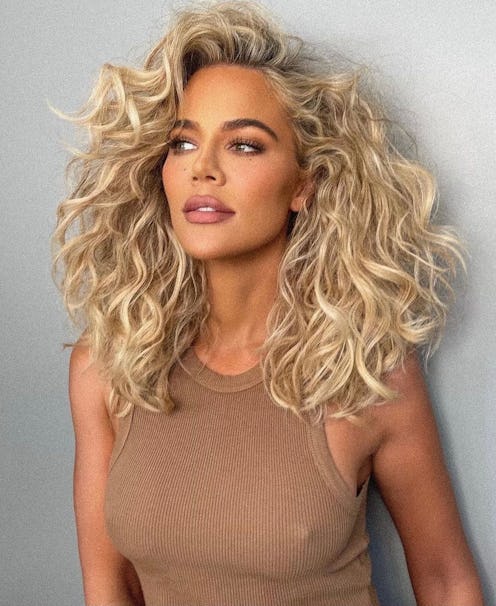(Hair)
You Might Be Getting Your Hair Cut & Colored In The Wrong Order
Turns out, one way *is* better than the other.

A few weeks after my first haircut in years — a chic shag with lots and lots of layers — I got the urge to update my highlights, too. Christine Thompson, my colorist and the founder of Spoke & Weal, noticed the fresh chop as soon as I sat down in her salon chair — apparently, thanks to those new layers, my balayage looked all kinds of wrong. (Whoops.) Thankfully, Thompson fixed me up in a few hours and let me pick her brain about cut and color protocol: Should you cut or color hair first? Should you have both done at the same time? Should your stylist and colorist be working together towards one cohesive look?
Read more: How To Trim Split Ends At Home Like A Pro, Even If You're Definitely Not One
For the most part, hair stylists and colorists have one approach to a haircut and dye. “Usually a lot of [stylists] wet cut,” Thompson tells TZR, “so they color the hair when it’s dry, then shampoo it, then cut the hair after.” But while that order may be more efficient for salons, it’s not necessarily in the best interest of your hair.
Instead, Thompson recommends approaching your haircut and dye in reverse: cut and then color. Below you’ll find all you need to know about why cutting and then coloring might be better for your hair.
First Cut, Then Color
“I prefer having the hair cut first, because then you can color the haircut exactly how it needs to be colored,” Thompson tells TZR, even though this technique goes against the grain of the salon world. For one, she says, processing hair that’s about to get the chop is a waste of time, energy, bleach, and dye. And secondly, current color trends tend to be dynamic — gone is the one-shade-all-over approach, but rather subtly blended, more natural highlights and colors.
“At one point, blonde pieces of hair were the same color blonde going all the way up to the scalp,” Thompson says. “Now, on one piece of hair you might have three or four different shades of blonde.” This method makes for natural-looking hair color and allows clients to go longer in between touch-ups; it’s also highly nuanced and requires thoughtful placement on the part of the colorist. Taking a pair of cutting shears to that kind of precision is truly a crime against good hair.
Bangs & Balayage, Beware
“Particularly for balayage, that’s a situation where sometimes people end up getting the bright bits cut off [if they do color first],” Thompson says — which is exactly what happened to me. Balayage highlights are strategically placed based on where the sun might naturally hit and lighten the hair; and by cutting layers into the existing pattern, I interrupted the flow of the color. The result? Blocky, fake-looking highlights. (Until Thompson saved me, that is.)
This really comes into play for those who have highlighted or balayage hair and bangs. A too-eager trim could erase all traces of color from your fringe — but luckily, Thompson has a fix for that, too. “I'll actually do a progressive technique to keep the color fresh on the fringe area, because I know it’s going to be growing out and getting cut,” she says. “Especially with the ‘Birkin bang’ situation that everyone is wearing, I do prefer aesthetically if it’s tipped with a little bit of light.”
To avoid awkward trims, the colorist works “a couple different levels of lightness” into the bangs. “The first bang trim, maybe half of that gets cut off,” Thompson says. “Then, by the second or third bang trim, they’re probably going to have to reset the color.” Fringe lovers, take note (and pass the note onto your colorist).
At Thompson’s Spoke & Weal salon — which has eight locations across the country, including New York City, Chicago, and a newly renovated space in Los Angeles — stylists and colorists (including co-owner and stylist Jon Reyman) prevent problems like broken balayage or wonky bangs from happening in the first place by taking a collaborative approach to each client’s cut and color, and doing both on the same day. “I don’t start coloring until I know where the cut is going,” Thompson says. “We’re really designing the color around the texture and how they’re going to be styling it.”
Sadly, not everyone will be able to have Thompson treat their hair with such loving care (she's a little busy with her high-profile clients, like beauty influencer Nam Vo and iconic model Pat Cleveland), but she has a few words of wisdom you’ll find useful no matter where you get your hair done. Her top recommendation? Find a salon that offers top-notch cuts and colors, and work with a two-person team to get the job done right.
If that’s not an option — for example, if you already have a stylist and colorist you love, and they work out of different salons — always opt to get your hair cut first, then bleached, dyed, or highlighted (preferably within a few days of each other). As Thompson says, “The cut’s going to make the color.”
This article was originally published on